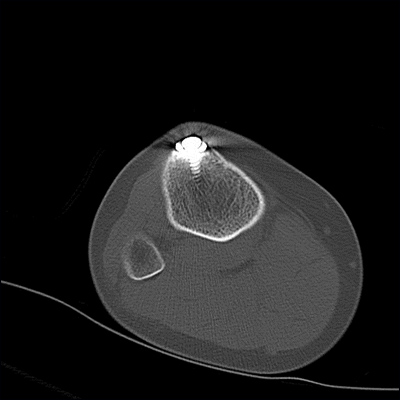BLOG: Revision surgery must be embraced in this demanding patient population
Patellofemoral surgery requires careful attention to the overall anatomy of the patient, including both longitudinal limb alignment and soft tissue balance. If the decision is made that bony malalignment is a major contributor to patellar instability, then tibial tubercle transfer osteotomy should be recommended.
Tibial tubercle transfer osteotomy, when properly executed, has the potential to deal with significant patella alta (through patella distalization) and coronal plane deformities identified by aberrant tibial tubercle to trochlear groove distance or excessive Q angle (though medicalization). If the medial retinacular soft tissues are evaluated and determined to be lacking, then addressing the medial capsular insufficiency at the time of surgical intervention is warranted.
Recurrent instability



Figure 1. CT scan of the tibial tubercle shows limited medial translation after index procedure.
Credit: Spang JT
Medial patellofemoral ligament reconstruction (MPFL) is one way to restore medial anatomy. Medial reefing and primary capsular imbrication at the time of tibial tubercle transfer may provide enough medial support in patients who retain robust medial tissues.
Despite the increasing understanding of the need to address both bone and soft tissue stabilizers about the knee, recurrent instability can occur. Orthopedic surgeons who develop a practice that includes an ever-increasing number of patients who have patellar instability will, at some time, have to deal with recurrent patellar instability.
For the majority of cases, recurrent lateral instability will be a typical presentation, but medial instability due to excessive tibial tubercle medicalization or over tensioning of an MPFL reconstruction have to be ruled out. Careful analysis of prior surgical techniques, new imaging and repeat physical examinations are all required if revision surgery is contemplated.

Figure 2. CT scan at the patella level reveals deficient medial restraint.
Credit: Spang JT
For the majority of patients with recurrent instability, a technical flaw in either the tibial tubercle transfer or an insufficient medial reconstruction (whether from MPFL or medial reefing) can be identified.
Revision tibial tubercle transfer
New imaging can be extremely helpful in the evaluation of the residual effects of prior surgery. In cases of prior tibial tubercle transfer, a CT scan is highly recommended to confirm hardware placement and to critically evaluate tubercle position. A CT scan is mandatory if revision tibial tubercle osteotomy is being contemplated as the prior osteotomy location and the tubercle relationship to the underlying tibia must be completely understood prior to attempting a new osteotomy cut.
In the patient example as shown in Figure 1 and Figure 2, the tibial tubercle transfer as evaluated by the CT scan around the proximal screw location has not resulted in sufficient medicalization. In the extended position, the resting leg still shows tremendous lateralization of the patella. At the time of the primary surgery, neither MPFL reconstruction nor medial tissue imbrication was performed.


Caption here. Following revision, tibial tubercle transfer and the addition of a medial patellofemoral ligament better alignment is seen.
Credit: Spang JT
In planning for an appropriate revision surgery, I find myself adding a formal MPFL reconstruction in almost every case. Simply put, addressing both the underlying bone architecture and reconstructing the medial tissues with a graft allows the surgeon to influence both the distal alignment and the medial constraints at the same time.
In my own practice, I have elected not to pursue trochleoplasty although those familiar with its use in both the primary and the revision setting have reported good clinical results.
For the patient in Figure 3, the CT allowed the team to successfully revise the tibial tubercle transfer. Concern over the quality of the bone did necessitate use of a washer and larger screws, a departure from our normal primary technique. The addition of an MPFL addressed inadequate soft tissues medially.

Jeffrey T. Spang
Although every surgeon strives to get it right the first time, revision surgery must be embraced in this demanding patient population. Surgeons should strive to evaluate and re-evaluate candidates for revision surgery. Complete and thorough physical examination should be undertaken at an initial visit and then repeated at a secondary visit after appropriate imaging is ordered. While MRI has great value in any situation, CT scan should be strongly considered as part of a preoperative workup for revision patients.
Lastly, a thorough review of some excellent technique guides for patellofemoral surgery will allow surgeons to eliminate technical errors that may increase the chance of surgical failures.
Disclosure: Spang reports no relevant disclosures.
References:
Dejour D, et al. Int Orthop. 2013; doi:10.1007/s00264-012-1746-8.
Harrison RK, et al. Sports Med Arthrosc. 2013;doi:10.1097/JSA.0b013e31828e88a2.
Tom A, et al. Sports Med Arthrosc. 2007;15(2):68-71.
Tompkins M, et al. Sports Med Arthrosc. 2012;doi:10.1097/JSA.0b013e31825c74cf.
Tjoumakaris FP, et al. Am J Sports Med. 2010; doi:10.1177/0363546509357682.
